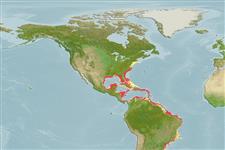>
Eupercaria/misc (Various families in series Eupercaria) >
Scaridae (Parrotfishes) > Sparisomatinae
Etymology: Nicholsina: After J.T. Nichols, 1920-1941, curator in ichthyology, department of Fishes, American Museum of Nat. History; he has wrote articles in the Encyclopaedia Britannica .
More on author: Valenciennes.
Issue
Issue on validity of subspecies: subspecies considered as valid in FB, elevated to species rank as Nicholsina usta (Valenciennes, 1840) in Eschmeyer (CofF ver. Mar. 2011: Ref. 86697). Please send references, or more studies are needed.
Environment: milieu / climate zone / depth range / distribution range
Ökologie
seewasser riff-verbunden; tiefenbereich 1 - 80 m (Ref. 7360). Tropical; 41°N - 30°S, 98°W - 34°W
Western Atlantic: New Jersey, USA and northern Gulf of Mexico to Brazil. Absent in Bermuda, Bahamas and West Indies (except Greater Antilles).
Size / Gewicht / Alter
Maturity: Lm ? range ? - ? cm
Max length : 30.0 cm TL Männchen/unbestimmt; (Ref. 7251); common length : 18.0 cm TL Männchen/unbestimmt; (Ref. 3802)
Rückenflossenstacheln (insgesamt): 9; Rückenflossenweichstrahlen (insgesamt): 10; Afterflossenstacheln 2; Afterflossenweichstrahlen: 9. Body somewhat elongate, the depth contained 3 to 3.2 times in SL. Snout somewhat pointed; a small dermal cirrus at edge of anterior nostril; teeth fused only basally, thus not fully coalesced to form dental plates. Gill rakers 12 or 13. Caudal fin slightly rounded; pectoral fin-rays 13. Median predorsal scales 4 or 5; 1 row of scales on cheek. Colour: mottled olive green on back, the scales of sides with bluish white centres and reddish edges; head below level of mouth yellow; 2 diagonal narrow red-orange bands on cheek; median fins reddish, dorsal fin with a black blotch at front.
Maximum depth from Ref. 52834. Inhabits seagrass beds and open bottom, mostly in shallow water. Larger adults live in deeper water. Not commonly marketed for food (Ref. 52834).
Life cycle and mating behavior
Geschlechtsreife | Fortpflanzung | Ablaichen | Eier | Fecundity | Larven
Distinct pairing (Ref. 205).
Robins, C.R. and G.C. Ray, 1986. A field guide to Atlantic coast fishes of North America. Houghton Mifflin Company, Boston, U.S.A. 354 p. (Ref. 7251)
IUCN Rote Liste Status (Ref. 130435)
Bedrohung für Menschen
Harmless
Nutzung durch Menschen
Fischereien: kleinfischerei
Mehr Information
ReferenzenAquakulturAquakultur ProfilZuchtlinienGenetikElectrophoresesVererbbarkeitKrankheitenVerarbeitungNutrientsMass conversion
PartnerBilderStamps, Coins Misc.LauteCiguateraGeschwindigkeitSchwimmstilKiemenoberflächeOtolithsGehirngrößeSehfähigkeit
Tools
Zusatzinformationen
Download XML
Internet Quellen
Estimates based on models
Preferred temperature (Ref.
123201): 22.8 - 28, mean 25.7 °C (based on 400 cells).
Phylogenetic diversity index (Ref.
82804): PD
50 = 0.6250 [Uniqueness, from 0.5 = low to 2.0 = high].
Bayesian length-weight: a=0.01122 (0.00535 - 0.02352), b=3.09 (2.91 - 3.27), in cm total length, based on LWR estimates for this (Sub)family-body shape (Ref.
93245).
Trophic level (Ref.
69278): 2.0 ±0.00 se; based on food items.
Widerstandsfähigkeit (Ref.
120179): hoch, Verdopplung der Population dauert weniger als 15 Monate. (Preliminary K or Fecundity.).
Fishing Vulnerability (Ref.
59153): Low vulnerability (20 of 100).
Nutrients (Ref.
124155): Calcium = 58.2 [34.4, 108.5] mg/100g; Iron = 0.767 [0.420, 1.278] mg/100g; Protein = 18.5 [16.5, 20.3] %; Omega3 = 0.118 [0.071, 0.190] g/100g; Selenium = 39.3 [22.3, 70.8] μg/100g; VitaminA = 50.4 [15.4, 165.1] μg/100g; Zinc = 1.75 [1.20, 2.74] mg/100g (wet weight);
